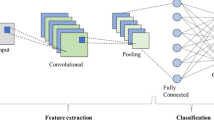Abstract
Kidney stones are the most common chronic disease nowadays. Solid minerals that accumulate can lead to various sizes and shapes of stones inside the kidney. It requires innovative models to improve patient diagnosis with high precision, minimizing radiologist burden and giving them a tool that can automatically analyze kidney health, lowering the chance of misdiagnosis to obtain treatment and maintain a healthy lifestyle. The main aim of the research is to accurately identify kidney stones from computed tomography (CT) using Deep learning models. We presented effective and unique pre-trained deep learning models VGG16, ResNet50, and CNN for the identification of kidney stones accurately. The eminence of the adopted models has been validated in terms of positive, negative, and neutral measures. Moreover, the accuracy of the ResNet50 model is 7.7 and 4.5% superior to the VGG16 and CNN models, respectively.
Access this chapter
Tax calculation will be finalised at checkout
Purchases are for personal use only
Similar content being viewed by others
References
Dauw CA, Simeon L, Alruwaily AF, Sanguedolce F, Hollingsworth JM, Roberts WW, Ghani KR (2015) Contemporary practice patterns of flexible ureteroscopy for treating renal stones: results of a worldwide survey. J Endourol 29(11):1221–1230
Zabihollahy F, Schieda N, Krishna S, Ukwatta E (2020) Automated classification of solid renal masses on contrast enhanced computed tomography images using convolutional neural network with decision fusion. Eur Radiol 30(9):5183–5190
Schieda N, Nguyen K, Ornhill K, McInnes MDF, Wu M, James N (2020) Importance of phase enhancement for machine learning classification of solid renal masses using texture analysis features at multi-phasic ct. Abdom Radiol 45(9):2786–2796
Yap FY, Varghese BA, Cen SY et al (2020) Shape and texturebasedradiomics signature on CT effectively discriminates benign from malignant renal masses. Eur Radiol 31(2):1011–1021
Aminsharifi A, Irani D, Tayebi S, JafariKafash T, Shabanian T, Parsaei H (2020) Predicting the postoperative outcome of percutaneous nephrolithotomy with machine learning system: software validation and comparative analysis with guy’s stone score and the CROES nomogram. J Endourol 34(6):692–699. https://doi.org/10.1089/end.2019.0475
Hameed BMZ, Shah M, Naik N, Singh Khanuja H, Paul R, Somani BK (2021) Application of artificial intelligence-based classifiers to predict the outcome measures and stone-free status following percutaneous nephrolithotomy for staghorn calculi: cross-validation of data and estimation of accuracy. J Endourol 35(9):1307–13. https://doi.org/10.1089/end.2020.1136
Alzu’bi D, Abdullah M, Hmeidi I, AlAzab R, Gharaibeh M, El-Heis M, Abualigah L (2022) Kidney tumor detection and classification based on deep learning approaches: a new dataset in CT scans. J Healthcare Eng
Cui Y, Sun Z, Ma S, Liu W, Wang X, Zhang X et al (2021) Automatic detection and scoring of kidney stones on noncontrast CT images using S.T.O.N.E. nephrolithometry: combined deep learning and thresholding methods. Mol Imaging Biol 23(3):436–45. https://doi.org/10.1007/s11307-020-01554-0
Elton DC, Turkbey EB, Pickhardt PJ, Summers RM (2022) A deep learning system forautomated kidney stone detection and volumetric segmentation onnoncontrast CT scans. Med Phys 49(4):2545–2554. https://doi.org/10.1002/mp.15518
Babajide R, Lembrikova K, Ziemba J, Ding J, Li Y, Fermin AS et al (2022) Automatedmachine learning segmentation and measurement of urinary stones on CT scan. Urology. https://doi.org/10.1016/j.urology.2022.07.029
Caglayan A, Horsanali MO, Kocadurdu K, Ismailoglu E, Guneyli S (2022) Deep learningmodel-assisted detection of kidney stones on computed tomography. Int Braz J Urol 48(5):830–839. https://doi.org/10.1590/S1677-5538.IBJU.2022.0132
Sudharson S, Kokil P (2021) Computer-aided diagnosis system for the classification of multi-class kidney abnormalities in the noisy ultrasound images. Comput Methods Programs Biomed 205. https://doi.org/10.1016/j.cmpb.2021.106071106071
Estrade V, Daudon M, Richard E, Bernhard JC, Bladou F, Robert G et al (2022) Deepmorphological recognition of kidney stones using intra-operative endoscopicdigital videos. Phys Med Biol 67(16). https://doi.org/10.1088/1361-6560/ac8592165006
Marchini GS, Faria KVM, L F Neto, Torricelli FCM, Danilovic A, Vicentini FC et al (2021) Comparing public interest on stone disease between developed and underdeveloped nations: are search patterns on google trends similar? Int Braz J Urol 47:989–96
Manoj B, Mohan N, Kumar S (2022) Automated detection of kidney stone using deep learning models. In: 2022 2nd international conference on intelligent technologies (CONIT), IEEE, pp 1–5
Yildirim K, Bozdag PG, Talo M, Yildirim O, Karabatak M, Acharya UR (2021) Deep learning model for automated kidney stone detection using coronal CT images. Comput Biol Med 135:104569
Kolli CS, Raghunath MP, Meenakshi S, Maheswari K, Britto CF, Kushwaha S (2022). Efficient development of supervised learning algorithm for kidney stone prediction. In: 2022 international conference on inventive computation technologies (ICICT), IEEE, pp 1373–1379
Moghisi R, El Morr C, Pace KT, Hajiha M, Huang J (2022) A machine learning approach to predict the outcome of urinary calculi treatment using shock wave lithotripsy: model development and validation study. Interact J Med Res 11(1):e33357
Author information
Authors and Affiliations
Corresponding author
Editor information
Editors and Affiliations
Rights and permissions
Copyright information
© 2024 The Author(s), under exclusive license to Springer Nature Singapore Pte Ltd.
About this paper
Cite this paper
Yamuna, V., Stalin Babu, G., Vijay Kumar, G., Manchala, Y. (2024). A Deep Learning Framework for Kidney Stone Prediction. In: Kumar, A., Mozar, S. (eds) Proceedings of the 6th International Conference on Communications and Cyber Physical Engineering . ICCCE 2024. Lecture Notes in Electrical Engineering, vol 1096. Springer, Singapore. https://doi.org/10.1007/978-981-99-7137-4_8
Download citation
DOI: https://doi.org/10.1007/978-981-99-7137-4_8
Published:
Publisher Name: Springer, Singapore
Print ISBN: 978-981-99-7136-7
Online ISBN: 978-981-99-7137-4
eBook Packages: EngineeringEngineering (R0)




